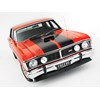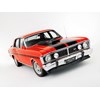Ford Falcon GT-HO Phase III Project: road test
 Project HO: let's go for a drive!
Project HO: let's go for a drive!

 Project HO: let's go for a drive!
Project HO: let's go for a drive!


|
|
Project HO: let's go for a drive!
|

|
|
Project HO: let's go for a drive!
|
It's done and dusted - so what's it like on the road?

|
|
Project HO: let's go for a drive!
|
Ford Falcon GT-HO Phase III Project: road test
Done, dusted, and unleashed. Project HO hits the streets on time and on budget.
We were thundering along some back road outside Melbourne, giving our brand new project car a bit of a gallop, when former V8 Supercar champ John Bowe, who was at the wheel, piped up. Clearly enjoying himself, he said, with a hint of jealousy in his voice, "Whoever wins this is going to be very, very happy." Then he started grizzling about not being able to enter the give-away…
Project HO is clearly addictive. And it has presence. Rolling it out the driveway on a Saturday morning was a matter of negotiating the two gawping teenagers who’d forgotten anything else in the world existed, and waiting for an increasingly unlikely gap in the traffic as a series of slack-jawed drivers slowed down to a crawl to get a look at the gleaming red beast.
Its Vermillion Fire paint, huge black stripes, purposeful rumble, plus the block-house early-’70s lines are a far cry from the hordes of muted Camrys that normally populate suburbia. Just being seen near it seems like an act of defiance.
Even those of us who have followed the Phoenix-like ‘birth’ of our XY GT-HO Phase III ‘Tribute’ are shocked by just how good the end result is. Walk around it, sit in it, go for a drive, it’s a stunner. We’re talking about much more than a mere lookalike, and even calling it a reproduction is understating what it represents.
This is in fact a new, hand-built vehicle; assembled to a higher standard than anything that rolled off the production line, though remaining ultra faithful to the original Ford product.
When the idea of giving away a HO was first raised, the inevitable question was how on earth could we afford one? A genuine Phase III can cost several hundred thousand.
You can however build a brilliant reproduction for around $150,000. Still too much? Well, anywhere else, that sort of money doesn’t actually buy you a lot when it comes to hand-built machinery. A genuinely good Phase III recreation would in fact be pretty good value at that price.
STARTING FROM SCRATCH
When project manager Phil Walker first strolled in to chat with Neil Thompson of Grand Tourer Restorations about tackling a project car, we had nothing but air. No car – just some grandiose ideas about what we’d like to end up with.
His approach from day one has been that, if you don’t have an actual Phase III with the correct numbers and the all-important ID plate, you’re best off starting from scratch. Working on someone else’s semi-finished project all too often means taking two steps back for every three forward as you correct the mistakes of others.
While he has the view "You can fix anything, if you have the time and resources," Thompson advises finding something that is fairly straight and structurally sound, or the bills can really get out of hand.
Ours was a paddock find with an unknown history, although we know it started life with a six-cylinder motor. Not intent on cutting any corners, the folk at Grand Tourer stripped the body right back and then had a couple of hundred hours of panel-beating time spent on it. You look at the bare Falcon shell and wonder how, until you see the subtleties of what’s required for a proper HO transformation. There are numerous brackets and braces to be fitted, quite apart from the basic repair work.
Our ‘HO’ needed new floor pans – one of many bits supplied by Rare Spares – along with dress-up kit like a modified bonnet to accept the engine’s shaker air-cleaner. In fact, this car got off light, as Thompson reckons he’s seen some spend 500 hours in the body shop.
One of the biggest dilemmas of any rebuild is the colour, and screaming ’70s Vermillion Fire was the unanimous decision.
So the body shell was surrendered to Matt, yet another bloke who works exclusively for Grand Tourer. Again, prep was everything. Matt spent hours going over the panels, filling and sanding the tiniest imperfections – most of which only he could see – before cleaning the thing as if his life depended on it.
With the main colour laid down, the real challenge was ensuring the black trim was spot-on. After all, you can’t present someone with a hand-built legend that has the bonnet stripes looking cock-eyed. Stare hard at the photos and you’ll agree the end result is almost impossible to fault.
MORE GRUNT, VICAR?
Loading 351 cubes of freshly-made Cleveland under the bonnet was next, but again there were decisions to be made. Originally the XY GT-HO only claimed 300 horses, though 350-ish was probably closer to the truth. While it’s now possible to extract 500 or more horses, we had to remember that this was a near 40-year-old chassis design and some lucky sod was going to want to be able to drive it without hitting the scenery. So driveability was key, with outright performance an important but secondary consideration.
With target horsepower of 400 in mind, typically Thompson started from the ground up. A good crank was sourced and sent off for machining at Duggans, along with the heads, with assembly tackled in a brand new engine room.
Aiming for a reliable package, the recipe called for a lightweight set of flat-top pistons running 10.5:1 compression – a little under the original’s for less stress on the engine.
Cam profiles are from the Phase II, which were also available in the Phase III and were the more aggressive of the two Ford options for this model. Thompson reckons it pulls well from next to nothing all the way to 6500rpm.
He also went a tad conservative on the carburetion, opting for a 650 double-pumper, rather than a 750. While set-up to look like the original, in combination with the cam it offers good urge off the bottom and a more user-friendly drive.
A nice touch was the alloy inlet manifold, painted to look like the original. Developed in-house by Grand Tourer, it’s designed to flow better and, more importantly not rust internally – something which can happen to stockers when they’re almost inevitably left standing for a month at a time.
All this alchemy is one thing, but did we get a result? Hell yes. The crew overshot their target slightly, with Danny at Selva Racing Power showing a peak of 426 horses on the dyno.
THE FINAL MILE
With the body and engine boxes ticked, next was the long hard road of turning it into a car. First up was the rebuild of the close-ratio Top Loader gearbox and nine-inch diff. While a notoriously tough combo, these ’boxes have a reputation for being grumpy and unco-operative, so the crew spent plenty of bench time ensuring the set-up was right.
Wheels and brakes are as per the showroom, while tyres are a retro-pattern German-made Dunlop; streets ahead of what was available way back in 1971, thanks to the modern compound.
Poke your head underneath and it’s as spick as the rest, including new suspension - dampers have also improved over time, though you’re stuck with the ‘cart spring’ rear – and steering.
Finally the fiddly but all-important trim and fit-out was sorted. The HO is a very simple beast by current standards, but this, the final mile of the build, seemed to take the longest time. While many of the parts were available, much also had to be done from scratch.
Again, Grand Tourer’s attention to detail came to the fore, right down to original paint flashes and spots in the engine bay. But our favourite is the flashy little sticker on the passenger side of the dash, warning occupants not to lower the windows at any speed above 100mph.
Okay, so it’s not a real HO, or is it? We asked Thompson early on what would be the difference between this and the genuine article. His answer: "The plate under the bonnet – that’s it."
A very big thanks to…
Grand Tourer Restorations, Melbourne: Did most of the work, and bent over backwards to get the project completed to a very tight deadline.
Rare Spares, nationwide: Supplied invaluable assistance with repair and replacement parts.
Duggans Balancing, Melbourne: Provided expert engine machining.
Classic Wiring Looms, Melbourne: Supplier of looms that plug straight in for a variety of classics.
Selva Racing Power, Shepparton: Expert dyno tuning and advice.
Stuckey Tyre Service, nationwide: Good advice on updating the rubber.
Shannons Insurance, nationwide: Provided 12 months comprehensive insurance for winner..
BEHIND THE WHEEL
So you’re probably thinking, how’s she go?
While Ford essentially designed the HO variant of the humble Falcon specifically to go around Mount Panorama very fast, it¹s actually quite comfortable. There¹s not a lot in the way of side support in the seats for the boy racers, but cruising down a country road is fun as you float along on what feel like old-style lounge chairs.
As with many big muscle cars of the era, the V8 lump out front can over-power the chassis. The leaf springs out back give the dampers a big job and, entering a bumpy turn, the back end gives warning that it will start to skate if you provoke it. However modern dampers and particularly the Dunlop Sport 2000 tyres on our car, plus the sorted and fresh steering, keep it tied down remarkably well.
But don’t expect much in the way of luxury. The driver scores a classic twin-binnacle speed/tacho and rather nice if old-fashioned three-spoke wheel. Forget air-conditioning, or a sound system; if the enthusiastic rumble of the Cleveland V8 isn¹t music enough, you¹re clearly in the wrong car.
Even John Bowe was impressed, after a few hot miles on some twisty back roads. "This is the best GT-HO I’ve ever driven, by a long way, and I¹ve driven a lot of them. It¹s like new. It’s a beautiful reproduction."
FAST FACTS
2010 Unique Cars’ Project HO
Body: steel monocoque, four door sedan
Engine: Cleveland 351ci V8
Drivetrain: front-engine, rear drive
Transmission: Top Loader close ratio four-speed manual
Power: 426hp
Performance: she flies!
Total prize value: $100,000 (on-road costs, delivery and 12 months Shannons insurance).
Unique Cars magazine Value Guides
Sell your car for free right here
Get your monthly fix of news, reviews and stories on the greatest cars and minds in the automotive world.
Subscribe

.jpg)








.png)



